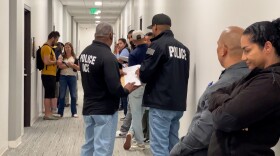During normal times, the concrete alleyway behind the Cathedral of the Blessed Sacrament in downtown Sacramento goes mostly unnoticed.
Cars and delivery trucks pass through, crows fly over at dusk and homeless people sleep there at night.
But since July, when California banned indoor religious services in many counties in order to stop the spread of COVID-19, this alley has been a place of worship.
One recent Sunday morning, about a 100 Catholics gathered six-feet-apart in the corridor for a 7:30 a.m. mass.
Some stood in a nearby parking structure. Others were in the parking spaces usually used by church staff. They sang faintly behind masks.
Father Michael O'Reilly preached from a fire escape, three stories above them.
"I'm a little afraid of heights," said O'Reilly, rector of the Sacramento cathedral.
But at the same time, he praised the opportunity. "It gives me a new perspective on the congregation here."
Rather than a choir, a solo vocalist led songs from the second-floor fire escape, far away from parishioners.
Maria Balakshin, who has been attending mass at the Cathedral of the Blessed Sacrament since the late 1990s, misses the beauty of the interior.
"Even though we're in an alleyway, they've made it as attractive as possible," she said.
After California announced in July that counties on the state's coronavirus watch list would not be allowed to have indoor worship services, Sacramento's bishop said Catholics could worship outdoors in affected counties.
Worship and sacred space
Modern-day Catholic worship rarely happens outdoors or outside of a church building. Canon law says the Eucharist must be celebrated in a sacred space, except when specific circumstances require otherwise, such as when large crowds gather to see the pope, or to accommodate migrant workers and soldiers during war time.
But normally, priests need to "make a good case" to offer a mass outside of a church building in the Sacramento Diocese, explains the Rev. Brian Atienza, who helped the bishop write the rules.
"If it's necessary to move it elsewhere, you can seek permission, but you have to make sure that the dignity of the sacrament is preserved, and maintained and respected," he said.
Susan Abraham, professor of theology at the Pacific School of Religion in Berkeley, says outdoor mass is not embraced by the Catholic church during normal times, in part, because there can be many distractions.
"There is a certain precision in the way the rituals and the sacraments are celebrated," said Abraham. "There is a wondering, will the going-to-the-outdoors compromise this precision? And I would say that is a legitimate worry."
For example, she said, most parishioners would be aghast at the idea of the communion wafer getting blown away in the wind or being soaked in a rainstorm.
Abraham, a Catholic herself, says the weekly experience of physically being in a church is meant to remind the faithful of God's holiness. But the pandemic is a good time to rethink that.
"I am not a fan of understanding only the church as a holy place or holy space," she said. "This is a new time for us to think about time and space in a far more expansive way."
During an August Mass behind Sacramento's cathedral, candles burned in the light of day. An organ filled the alleyway with music. Father O'Reilly preached about not letting anything get in the way of being close to God, not even a virus. Some parishioners knelt on the cement pavement as they worshipped.
Maria Balakshin said attending mass outdoors has been a very spiritual experience.
"To me, personally it is more intimate," she said. "The people who are here are really true Christians who want to practice their faith."
This congregation's prayers may be making this alley more sacred during the pandemic. But when California lifts the ban on indoor worship, these parishioners will likely go back to church as usual inside the cathedral.
Copyright 2020 CapRadio News. To see more, visit CapRadio News.






